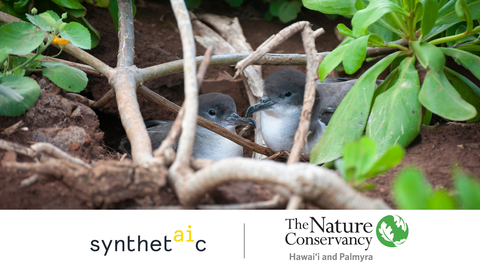HONOLULU--(BUSINESS WIRE)--The Nature Conservancy (TNC) announces that artificial intelligence (AI) powered imagery analysis detected two more seabird species at Palmyra Atoll (earlier this year, a grey-backed tern chick was observed, documenting the success of seabird attraction methods). Using a Rapid Automatic Image Detection (RAIC) tool developed by TNC partner Synthetaic, scientists were able to detect a blue noddy (Procelsterna cerulea) and a wedge-tailed shearwater (Puffinus pacificus) at Palmyra Atoll.
Both birds were believed to have been extirpated, or made locally extinct, during World War II, likely due to disturbances to their habitat and the introduction of predatory, invasive rats.
TNC gathers drone imagery to observe, measure and assess the health of the atoll ecosystem. While using drones minimizes human impact on the environment, it creates terabytes of data that is cumbersome for humans to analyze. Synthetaic’s AI tool analyzes the visual data to return matches for a given image, in this case, birds.
“We would never have found either of those birds looking at the image data on our own,” says TNC’s Island Resilience Lead Scientist, Alex Wegmann. “There was too much data, the imagery was too complex, and we were focusing on different bird species. By analyzing our data in RAIC, the information about these birds became accessible in a way it wouldn’t have been otherwise.”
Starting in 2020, TNC and partners began working to return eight seabird species that are known to the region but not currently found on the atoll. TNC and the U.S. Fish and Wildlife Service co-manage Palmyra Atoll as a TNC preserve and research station within a National Wildlife Refuge. Bringing the birds back is part of the long-term restoration of the atoll, which also includes eradicating the rats and restoring the tropical forest.
"Confirming more seabirds returning is a validating sign for the management actions we’ve taken since purchasing the atoll in 2000,” says Katie Franklin, Palmyra Island Conservation Strategy Lead. “Seabirds are important because their nutrient-rich guano plays a central role in the health of atoll ecosystems, including their resilience to climate change,” she says.
Synthetaic partners with TNC through its AI for Impact program, through which the company collaborates with non-profit organizations to help them harness RAIC for real-world results.
Akasha Sutherland, Director of the AI for Impact Program, says, “It’s an honor to put this tool in the hands of organizations tackling some of the most important problems in the world.”
Other AI for Impact use cases have included search-and-rescue operations and identifying sources of methane emissions.
TNC’s experience using RAIC to successfully analyze drone footage demonstrates the value of this tool for conservation. In addition to helping TNC answer important questions about seabird populations and habitats, it will next become part of the measurement toolkit for a coalition doing similar restoration work at Tetiꞌaroa Atoll.
“I strongly believe that what we’re doing at Palmyra is scalable and repeatable, and tools like RAIC make that possible,” says Wegmann.
Images available here: https://www.dropbox.com/scl/fo/t1t60o2oo1ooku61eufma/h?rlkey=dgu5wy705dero55c3mbz7nzyi&dl=0
About The Nature Conservancy
The Nature Conservancy is a global non-profit organization dedicated to conserving the lands and waters on which all life depends. Informed by science and guided by traditional values and practices, we apply innovative, nature-based solutions to our world’s toughest challenges so that nature and people can thrive. TNC has forged partnerships to manage 14 preserves and other sites in Hawai‘i and Palmyra Atoll, working with government, private parties and communities to protect Hawai‘i’s and Palmyra’s forests and coral reefs for their ecological value and for the many benefits they provide to people. Visit www.nature.org/HawaiiPalmyra.
About Synthetaic
Synthetaic builds software that lets our customers create AI solutions in minutes, not months. Synthetaic’s RAIC (Rapid Automatic Image Categorization) solves AI’s underlying data-labeling problem by eliminating the need for time-intensive human labeling or expensive labeled datasets. RAIC automates the analysis of large, unstructured datasets and offers instant detection of anything, at scale. It’s the way AI is supposed to work. Our solutions have been applied to critical use cases across industries, including geospatial, defense, security, science, technology, conservation, and more. To learn more, visit synthetaic.com.




